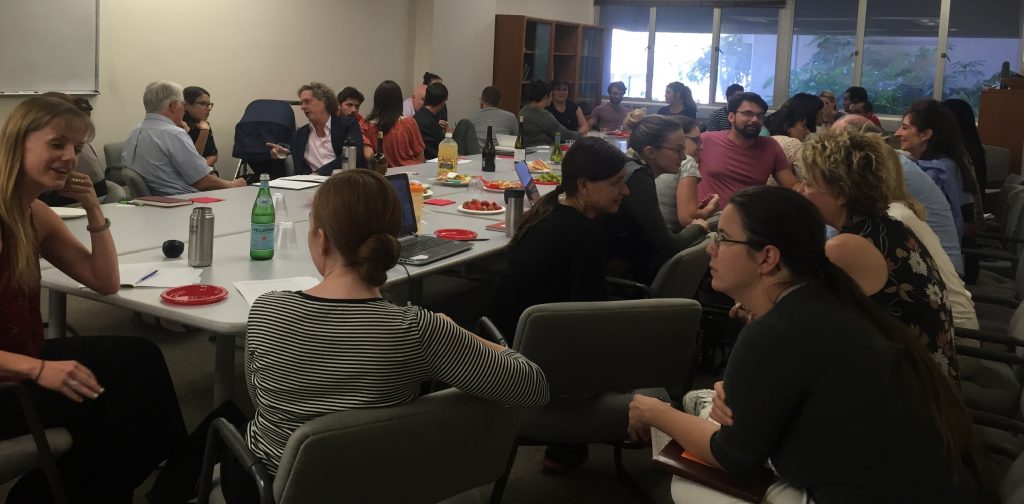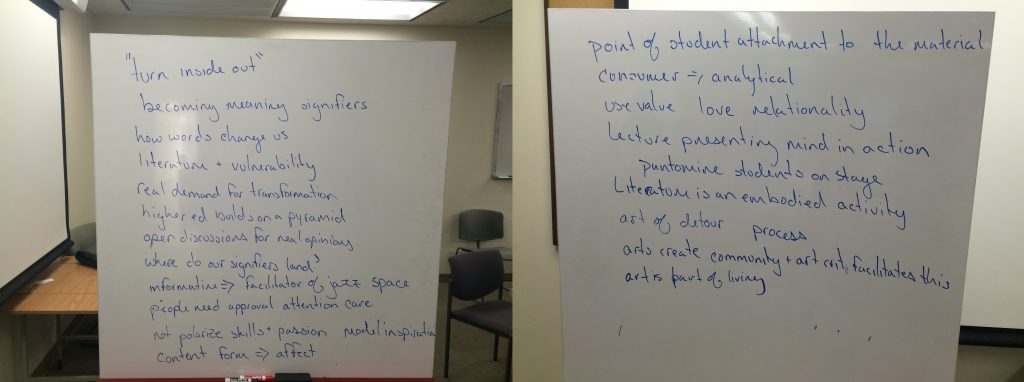Corinne, Nicole, Rachael, and Katie began the meeting by sharing a few remarks about the exigency motivating the initiative. We then invited the 14 professors and 25 graduate students who attended to write an important teaching/ learning moment on a 3 by 5 card that we had placed around the table. In general, graduate students sat around the conference table and professors sat in the chairs along the wall, so when we asked people to share their formative teaching moment with the person behind or in front of them, almost all the pairs were comprised of professors and graduate students. These reflections ultimately served as the text or object around which we oriented our discussion, which proceeded organically after this initial activity.
Although the central question “What does it mean to teach literature?” was not explicitly answered many of the responses and remarks fell into two categories– ideas about what constitutes good teaching in general and thoughts on our particular content: the potential of the signifier and the transformative power of literature.
Good teaching, in general, depends on:
Attention and acknowledgement:
There seemed to be broad consensus that good teaching depends the attention and acknowledgement we give to our students. As Lisa, drawing on her experience teaching high school, pointed out, students are fundamentally seeking the support of their instructors. They want to know that their instructors are not an oppositional force, but rather a force that holds them up and pushes them forward. As instructors, we must make sure that this attitude is explicitly communicated. This is possible even in the space of a lecture hall. Bishnu suggested that even in addressing a single student during a lecture a professor can signal not only the importance of the student’s observation, but also the professor’s openness to student input.
Awareness of relationality:
This fundamental attention is made possible by an awareness and sometimes explicit acknowledgement of the relationality of the classroom— the students, the professor, the text and even the physical space itself. Kay shared the epiphany in which she realized that her teaching role was not primarily to inform, but to facilitate the coming to knowledge of scores of student minds. She can draw on the thoughts and feelings of her students to attend to the literature in a way that creates something new and meaningful. Julie explained that by foregrounding our own relationship to the text, professors show students we are really trying to talk to them and not simply putting on a performance. Aranye named this concept “inspirational modeling” where through lecture, a teacher can show that because a text is meaningful for the instructor it can also be so for her students. She cautioned against polarizing skills and passions and Felice added that professors must think about the relationship between the lecture form and the content of their classes in order to direct the affective experience of their students. Kristy contributed a formative teaching moment in which her instructor shared her own experiences being rendered vulnerable by a poem in a way that facilitated her own students’ emotional and intellectual engagement with the work. Katie and Bishnu shared anecdotes about how an in-class analysis of the classroom, as an institutional and social space, itself facilitated and improved their students’ engagement with each other and the texts.
Building on prior knowledge:
Many strive to show students that college-level study builds on prior knowledge and activities. Alan pointed out that in the United States, higher education is the capstone of the K-12 pyramid and many of the strategies those teachers use are still effective in college (such as show and tell, playing games with Derrida, and demonstrating power by asking his (male) students to drop and give him ten). Colton explained how he tries to convince students that they are not just consumers of knowledge, but also already the owners and critics of that knowledge.
But all these values could apply to teaching anything. What makes literature any different?
Our particular content: the potential of the signifier and the transformative power of literature
Aranye opened the conversation by sharing her formative learning moment, which occurred during a lecture on John Donne. She realized that the signifier is always floating and seeing it is an act of passion; that these floating signifiers are the only way we have of making meaning. Teachers have the power to turn students on to this understanding– to open themselves up to the transformative power of words, which Aranye argues resonate with our very bodily processes; she says “undergraduates are changed to the atoms by what they read.” Julie shared some innovative teaching strategies about how to facilitate the embodied experience of reading poetry with her students. For instance, she does a pantomime of the first 60 lines of Book 13 of The Prelude in order to lighten the tone but also clarify what the lines are depicting or invite students on stage to use their feet to fill the lecture hall with the rhythm of the hooves Tennyson describes in Charge of the Light Brigade. Julie strives in her lectures to not only present “a mind in action” but also to share with students the embodied experience of reading. Felice also asserts that helping students to see the transformative power of literature activates their own ability to create change in the world. Felice points out that it’s a two way street concerning transformation not just assimilation of knowledge, and students voice a real demand for transformation. This mode of reading signifiers with a capacity to critique and an openness for change renders a professor’s words as a text in itself. For instance, Bishnu shared an example of teaching a postcolonial literature class in a previous institution’s military science building that had a poster which read: “the meek shall inherit the earth; they will be buried in it.” As mentioned above, Bishnu incorporated an analysis of the space and the poster into her class, and at the end of the semester a student chose to take up Bishnu’s spatial critique in her final paper, considering what it meant to read the postcolonial texts in a space framed by a message promoting military interventions. The signifier of Bishnu’s opening lecture landed in her students mind in a local instance of transformation.
Katie pointed out that justifications for the humanities and literature often create an imperative for a use-value, but we too often overlook the fact that desperation or love are ends in themselves. We read because we have no better way of tearing down the socially constructed walls between people and the boundaries of our own skin than picking up a piece of fiction and talking about it with others. Aranye commended Colton’s previously mentioned comment that we seek to show our students that they already practice literary criticism in their everyday lives. Aranye added that art brings out powerful emotions in people that facilitate social bonding. We need to recognize the community-creating function of art criticism, even of the most informal kinds. Living demands our participation in artful activities– studying art or literature is not a luxury, but an essential part of how we can make any meaning in our lives.
*If we did not fully represent your ideas or insights, please write to us and we will amend our paraphrases of your responses.





